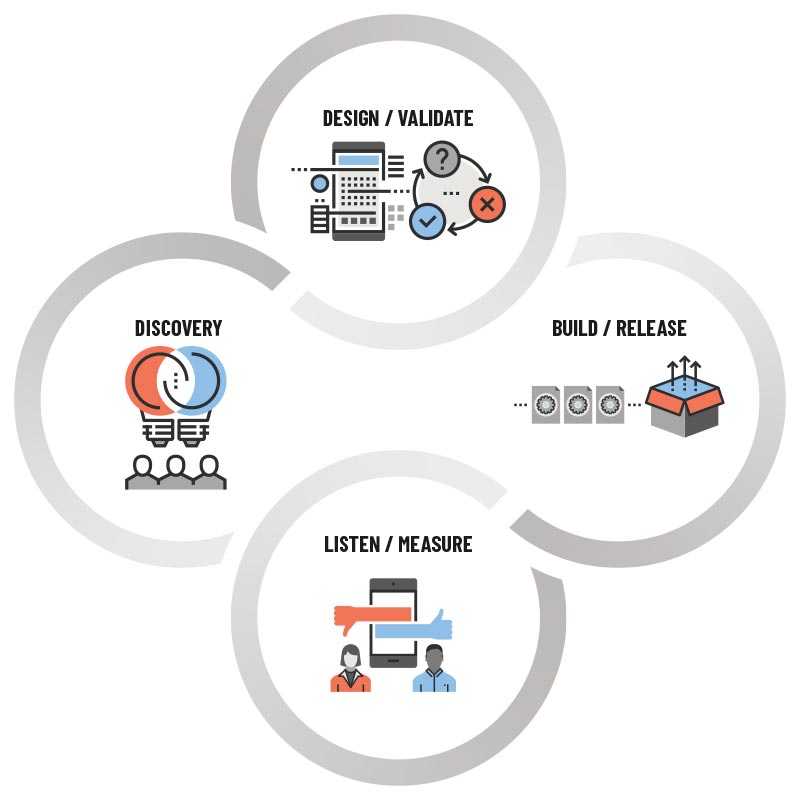When product teams put together budgets for new products or product releases, they often struggle to determine how much money to allocate for UX research and testing.
This confusion flows from uncertainty about how to view UX’s role in the product development process. Is UX a one-time project with precise parameters and a predictable scope, like designing a logo? Or is it an ongoing program of activities that ought to be woven through the entire development process? Where you land on this question will determine your approach to UX spending and the potential return on your investment of UX research and design.
The question of how to budget for UX is something we’ve spent a lot of time discussing with our clients over the years. The reality is that UX programs that get results are never “one and done.” UX is an ongoing commitment to improving a product’s usability, one that requires dedication and flexibility.
One-time, project-based budgeting will inevitably hamper the efficacy of your UX program. Like retirement planning, your UX program should be viewed as a long-term investment. If managed wisely, it’s an investment that will pay dividends in the form of a superior product that meets and exceeds your users’ needs every time.
Budgeting vs. Investing: How to Think About the Potential Return on Investment of Your UX Research & Design Spend
Product teams working with UX agencies for the first time often come to the table with a project-based mindset. This mindset impacts how they expect to engage with the agency and how much they expect to spend. That’s understandable. EdTech companies want to know exactly what they can expect to receive from their UX partners and what those deliverables will cost.
Project-based budgeting affords that level of certainty. For that reason, it may feel like the safest bet for first-time agency partnerships. But that doesn’t mean it’s the best fit for an optimized and holistic UX program in the long run.
We recommend approaching your UX spend as an investment managed by strategic budgeting. This means you should plan for a more holistic UX budget pegged to a particular event or time frame (such as a product release, quarter, or fiscal year) rather than an individual UX project (such as a single round of UX design or user testing). Your UX agency should work with you to allocate your overall investment in a customized program of individual UX projects.
Some EdTech companies struggle with this model because it means they must commit to a certain level of funding without knowing at the outset what the exact set of deliverables will be. Of course, the success of this model is predicated on a certain level of trust between your team and your UX agency. With an investment model, what you lose in terms of certainty, you gain in terms of flexibility and efficacy.
Here are a few reasons why an investment approach to UX budgeting is ultimately your best bet:
- UX work isn’t a singular event; it’s a cyclical and integral part of product development. UX design, research, and testing form an essential component of EdTech product development at all phases of the process. Often, a single product will have multiple UX projects occurring inside of a single release cycle. In addition, the results of any given phase of UX work has implications for what needs to be done next. In some cases, the results of one leg of UX research may reveal the need to pivot in an entirely new direction. It would be next to impossible to predict in advance exactly when and how a UX team should focus their efforts over the life of a product. When UX activities are circumscribed by a limited, project-based budget, product teams are much less likely to respond to UX needs as they present themselves. Investing rather than budgeting allows the product and the needs of users to drive UX activities.

- A UX investment “nest egg” allows you to flexibly build out the best-fit UX program for your product. The way you structure your UX spending impacts your ability to anticipate and flexibly respond to UX challenges as they arise. Sure, it’s possible to review and approve individual budgets for each UX project within a product release, but it’s definitely not the most efficient way to go about it. Every time you pause to go through a budget creation and approval process, your team loses valuable time that could be spent moving your product closer to the finish line. If, on the other hand, you plan for a longer-term nest egg of UX funding, you enable your UX team to strategically allocate funds for the most effective initiatives to move forward on your product roadmap.
- UX agencies are most effective in long-term partnerships. Developing a long-term partnership with your UX agency allows them to develop additional expertise related to your specific brand, product, and users. This familiarity gives them an edge in making strategic and informed decisions for your product. A project-based approach to partnering with UX agencies means that it could take much longer for your agency to get up to speed on those same business and user needs.
- Investing in UX allows your agency to pursue individual UX activities according to the most optimal schedule. Partnering with an agency using an investment-based model allows your team to flexibly plan their UX activities according to a best-fit timeline. For example, at Openfield we use our deep understanding of EdTech release cycles and the demands of the academic calendar year to throttle our UX activities. We know that instructors and students are typically unavailable beginning in mid-November through the new year. As a result, we stage major UX research initiatives in the early fall, before the hustle-bustle of finals and holidays roll around. This allows our clients’ engineering teams to make their final development pushes in November and December — in time for the EdTech product release cycle beginning on January 1.
UX is a critical component of your product’s success. Treat it like the investment it is, and you and your users will reap the rewards.
